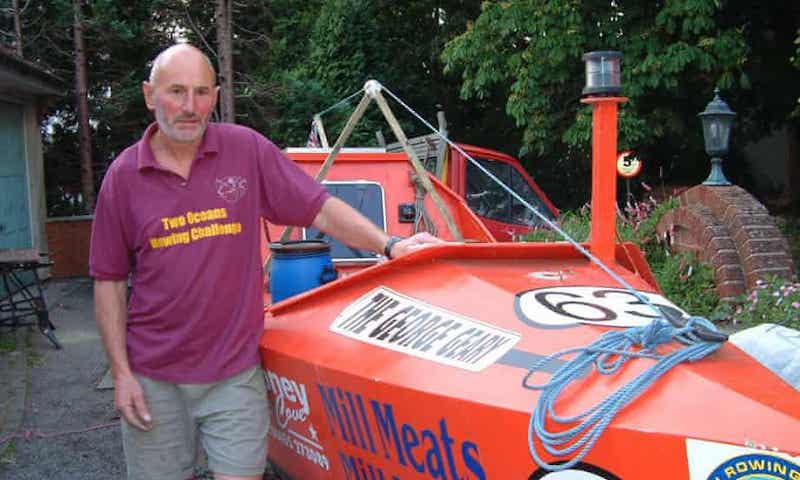If you think you’re having a bad week, wait until you hear about the one Graham Walters has experienced. The British ocean rower was set to complete his journey across the Atlantic, and write his name in the record books in the process, but may see his accomplishment nullified due to poor weather conditions in the Caribbean. After finishing that journey yesterday, he now waits to see if he will come up just short in his bid to become the oldest person to ever complete a solo row across an ocean.
The 72-year old set off on his journey back on January 25, departing from the Canary Islands with the goal of reaching Antigua in the Caribbean. He then spent the next 96 days out on the water, slowly but steadily making progress towards his goal. Over that period of time, he rowed for more than 5000 km (3106 miles), spending countless hours at the oars. The journey was fraught with numerous challenges, with Walters himself admitting that in the beginning he was cold, wet, and miserable for much of the time. Eventually the weather would improve however, but other difficulties would arise. As with many other ocean rowers, he would struggle to keep his water purifiers working and he suffered an injury to his knee when a big wave struck his small boat. As if that wasn’t enough, the lights suffered a malefaction and his cabin had a leak that allowed water to seep in as well.
While all of those things made the journey a tough one, Walters persevered and managed to cross the Atlantic entirely by himself. It looked as if he would arrive in Antigua yesterday, setting the new age record as a result. But just 10 km (6.2 miles) from the finish line, he began running into problems. Extremely high winds blew him off course and sent his rowboat past his landing spot on the island. Walters struggled hard to bring the ship into shore, but despite those efforts he simply was unable to do so. In the end, he received assistance from the local coast guard, who towed him into the harbor and safety at last.
But, that’s where the disappointment could set in. After traveling more than 5000 km, Walters has to receive assistance to finish the row, which may nullify his status as “solo and unsupported.” After spending more than three months alone at sea, the final few hours may prevent Graham from achieving his goal. He is currently safely on shore and awaiting the judgement of the Ocean Rowing Association to see if they’ll recognize his accomplishment. Depending on how they rule, he may find that he came up just a little short.
- Gear Review: The Xero Scrambler Mid is an Ultralight Hiking Shoe for Spring - March 1, 2023
- Gear Review: Yeti Roadie 48 Wheeled Cooler - August 18, 2022
- Kristin Harila Continues Pursuit of 8000-Meter Speed Record - August 16, 2022

So this poses an interesting question. All these rowers are not actually rowing but relying on the ocean currents to float from A to B. If this is the case, the entire enterprise of ocean “rowing” is a joke. Could not this guy just row harder to get back on course??? Oh, wait, he is not actually rowing but floating. Another stupid sham like “climbing” Everest where the paid coolies do all the actual work.
That’s kind of a gross over simplification of things, wouldn’t you say? Ocean currents actually flow in multiple directions and can sometimes aid a rower or work against them. It takes a lot of hard work to row 3100+ miles. To get a sense of what it is like, just take a row boat out on a calm lake and see how physically challenging it can be. An ocean would be far more difficult still, with big waves, high winds, and constant swells. Int his case, Graham also spent three months completely alone out on the water, which is not an easy environment to be in.
As to whether or not he could “row harder to get back on course” this isn’t a case of him not being able to move, but instead not able to make the very subtle navigation and movement necessary to arrive where he was suppose to end. The high winds were making it very hard on him (again, give a try yourself) and he was about to overshoot his intended stopping spot and potentially end up continuing his journey. Remember, he’s already been out there for three months and was likely running low on supplies. He was also not approved to land somewhere else and Antigua is the traditional stopping point for most of these transatlantic rows.
Kraig, no question about the mental and physical challenge but the real question is: how much “rowing” is involved? Perhaps “controlled drifting” is a better description:
“The solo crews (and pairs) may well be rowing for all they are worth for 8-12 hours a day, but their efforts are actually far less effective than the power of the wind and current. So these extreme athletes are very likely to DRIFT much further than they ROW! This “inconvenient truth” challenges the essential nature of these expeditions, demands that the rower maintain a constant state of denial, but is never mentioned in the stories that make the headlines.”
“And definitely no mention of the satisfaction of feeling your craft rolling along in the tradewinds and ticking off the miles that sailors typically experience. However, you don’t actually need oars or a sail to cross the Atlantic, if you choose the right kind of boat….”
http://www.sea-to-summit.net/opinion-ocean-rowing-an-exercise-in-futility/
Carlos, go and try a feat like this yourself and see how idiotic your comment is.